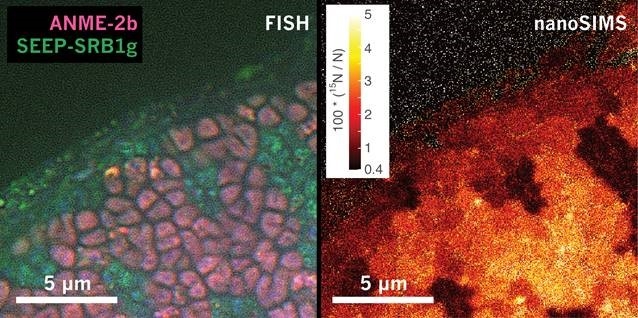The Science
Sediments on the ocean floor contain large amounts of methane. This methane can seep from sediment and serve as a food source for microbes. Two groups of microbes work together in symbiosis to break down this methane in sediments that do not contain oxygen: methanotrophic Archaea (referred to as ANME) and sulfate-reducing bacteria (referred to as SRBs). Several species of ANME and SRB have been found in nature, and they interact in specific ways. To do so, they need nutrients such as nitrogen. Previous studies found that ANME can fix nitrogen gas and that this nitrogen can serve as a nutrient for both ANME and SRBs. This new study examined whether some SRBs in the symbiosis can also fix nitrogen. The research found that a newly identified type of SRBs has the genes necessary for nitrogen fixing. The work showed that ANME and SBR can both fix nitrogen, but they do not do so at the same time. Instead, they appear to trade places depending on environmental conditions. The ability of both partners to fix nitrogen likely allows microbes to hedge against changes in their environment and helps them expand their niche.
The Impact
Methane is a powerful greenhouse gas that is abundant in marine sediments. Processes that affect how methane breaks down have important implications for the global carbon cycle. This study suggests that certain microbes can sometimes trade places to fix nitrogen and satisfy their collective nutrient demand for methane. This versatility likely stabilizes the persistence of populations of organisms that rely on methane when conditions are variable. This versatility may affect the overall methane emissions from marine sediments.
Summary
Anaerobic methanotrophic Archaea (ANME) form syntrophic association with sulfate-reducing bacteria (SRB). Their symbiosis facilitates the anaerobic oxidation of methane (AOM) in marine sediments and thereby modulates its flux to the atmosphere. Different clades of ANME and SRBs are known to form specific, paired associations, though the reasons for this specificity are not yet well understood. This research used DNA data to identify a new group of SRBs and its ANME partner. Researchers also looked at genome data to find out which of these microbes can fix nitrogen. This suggested that the newly found SRBs have the genes necessary for this process. They then used isotopes of nitrogen, measuring its uptake, and made images of where it can be found in clumps of cells.
Specifically, this study used network analysis of microbiome data for methane seep sites southwest of Costa Rica to identify a novel clade deltaproteobacterial SRB (SEEP-SRB1g) that forms associations with a distinct ANME clade. The study used biorthogonal non-canonical amino acid tagging combined with fluorescence-activated cell sorting (BONCAT-FACS) to further confirm this association. Similarly, fluorescence in situ hybridization (FISH) microscopy revealed the co-occurrence of both species in microbial aggregates. To explore the physiological basis of this association, the researchers analyzed metagenomic data and mini-metagenome data from FACS-sorted aggregates. Data indicated the presence of the complete operon for nitrogen fixation in the genome of SEEP-SRB1g. Anaerobic methanotrophic Archaea, but not their SRB partners, had previously been recognized to play a dominant role in N fixation of ANME consortia. To confirm the role of SEEP-SRB1g in N fixation, its nifH gene was targeted via whole-cell hybridization chain reaction FISH (HCR-FISH) and mRNA transcription was detected. To validate N-fixation, researchers incubated ANME-2b/SEEP-SRB1g consortia in the presence of 15N2 and analyzed cellular aggregates via FISH-nanoSIMS. In most cases, ANME-2b were significantly more enriched in 15N than their SRB partner, consistent with prior reports. However, experiments also indicated that in some circumstances SEEP-SRB1g can fix more nitrogen than its ANME-2b partner. This spatiotemporal heterogeneity of the N-fixation phenotype potentially allows methane utilizing populations to adapt to environmental variability and likely influences the efficiency by which methane is mineralized in marine sediments.
Funding
This work was supported by the Department of Energy Office of Science, Office of Biological and Environmental Research.




